
"Each creature began to hone its daggers on the rough bark."
The Daggerwrist is an aggressive, arboreal, agile, gregarious, predatory, viviparous, gliding quadrupedalien found exclusively in the Pocket Forests (mostly in the canopies) of Darwin IV. They live in groups and look out for their offspring. It is the most overtly social creature Barlowe encountered on Darwin IV. As these are denizens of the upper treetops, Barlow discovered their presence only by chance. When in branches closer to the dark forest floor, their red bio-lights glow. The species was first found one day in one of the largest pocket-forests that the First Darwinian Expedition had found and surveyed, a relatively short distance from the Planum Pytheas in Planitia Borealis.
These creatures can be seen partially hidden, remaining motionless, in the leaves of plaque-bark trees and among the translucent floatballs.
The human-sized creature can perch rigidly on a thick branch with its two dagger-terminated arms held out before it in a menacing state of readiness. When it senses the presence of a different species it instinctively assumes this defensive threat posture. It accompanies the fierce stance with an intermittent and somewhat raucous pinging which, can sometimes immediately be repeated by an intruding fellow daggerwrist. This sometimes garners instant and startling results.
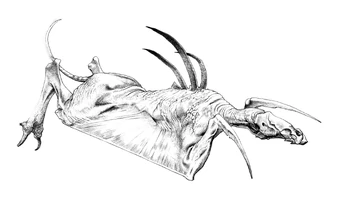
While there are many parachuting herbivores in Darwin IV's forests, the daggerwrist is the only gliding predator known to date. Any injury to the glide-membrane is serious, and large tears result in an inability to hunt and, thus, survive.
Without hesitating, the resident daggerwrist will sometimes attack the intruder. Extending its long arms to expose a substantial gliding membrane, and propelled by its powerful ricochetal hind legs, it leaps straight for its opponent and can cover 10 meters in one shocking bound. It can hang on the surface of a tree by its two curved and horny daggers: somehow it manages to hook them into almost any surface.
The daggerwrist is a fierce-looking beast with sinewy muscles that cover its two-meter-long body from its neck to its whipping tail. Great purple veins can sometimes bulge on its belly.
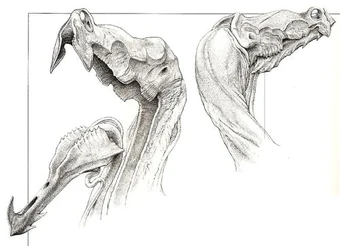
Two head studies showing the complex jaw interface as well as the two independently mounted portions of the skull. The heavily muscled tube is used exclusively to move and propel the barbed mandible. The remaining thin tubes pump digestive fluids into and out of the mandible.
It has a bony head; and what appears to be a complete skull with an attached jaw is, in reality, two separate and unattached pieces. The "cranium" obviously houses the brain and the well-developed sonar projector-receiver. The hooked "jaw" is connected directly to the creature's breast by three thick muscle-covered tubes. For brief instants this pseudo-jaw will separate from the "cranium" and writhe and probe about in a snakelike manner. It would seem that this is the closest any creature on Darwin IV comes to actually possessing a working jaw: for when the two pieces do come together, a razor-sharp, scissor-like interface is created.
If a daggerwrist ever does lose grip with its twin daggers and falls it opens its gliding membranes, arches its back and flips over backward to parachute to the foliage below. This display of aerobatics is even more impressive than the attacking leap.
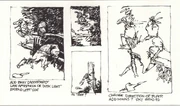
Living in massive, hollowed plaque-barks can be a dozen or more daggerwrists. If there is any creature other than the floating Eosapien that exhibits well-developed social behavior upon Darwin, it is the arboreal Daggerwrist.
Daggerwrists can climb with incredible rapidity to the uppermost branches. Some use their hooked "hands" to swing from branch to branch, while others hammer them into the trunks to climb as if with pitons. Their climbing abilities are truly astonishing. Troupes can encircle other species of creatures they may have not encountered before in the branches at a respectful distance, careful to avoid any false moves, studying the other species for a greater part of an hour before making significant moves. It is imagined that daggerwrists can feel more secure in their own territories surrounded by their compatriots.
The largest individual in a group is likely the dominant individual. The creature is larger than most of its companions and appears to be older, but it is not just these physical characteristics that lead to these conclusions. The other daggerwrists sometimes seem to melt away as this larger individual approaches.
Each individual can hone its daggers on the rough bark, producing a couple of harsh scraping sounds.
Nearly every individual shows some degree of physical damage. It is hard to believe that so many injuries are the results of falls, especially since the creatures have ease in the branches. In addition, many of the scars seem to be from punctures and slices. All this leads to the theory that the daggerwrists are a fairly aggressive breed and that their wounds are the results of ritualistic combat.
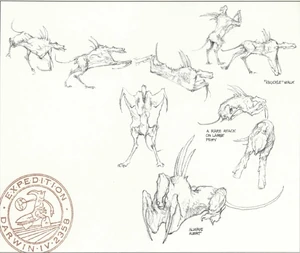
Daggerwrists are extremely active animals and can assume both quadrupedal as well as bipedal stances. They frequently use their daggers to hang and swing from branches.
Arrayed as they are in the branches circling their huge tree-home, the daggerwrists are easily able to guard against unwanted visitors. Any twig that snaps brings the high-strung creatures to attention; any unfamiliar pings send them into defensive threat postures. These interruptions are seldom the result of anything truly threatening, and it takes very little time for the troupe to resume its normal activities. They can withdraw into the hollowed trunks of their nest-trees and curl up to rest.
When they sense the sonar of a rival lone daggerwrist approaching their territory area, they poke their heads out, inquiringly, from the many meter-wide holes in the trunk. Some climb out and settle into the branches, while others continue to doze. The big lead individual emerges from the trunk and climbs to a high position to survey the entire leafy amphitheater around the home tree. The powerful individual seems almost expectant as it begins to hone its long daggers. Moments later the approaching new daggerwrist comes into view and, hesitating at the edge of the territory, sits down upon a tree limb. It may be as large as the big leader. It, too, begins to noisily sharpen its daggers. The newcomer raises itself upon its hind legs, opens its membranes and springs to a branch closer to the leader. This move may be too much for the resident leader. Emitting a shrill ping and, extending daggers, the leader will battle the opponent.

When taking down a victimized prey animal, a daggerwrist first uses its daggers to severely injury its prey. Then, instead of going for the throat, the predator sinks its daggers deep into the victim's sides (either on a tree branch or on the forest floor) and holds on. Almost simultaneously it uses both "jaws" to tear out an ugly, ragged hole in its victim's body. The daggerwrist then inserts and anchors its hooked feeding jaw and begins to pump digestive fluids into the dying victim's chest cavity. For the next 20 minutes a daggerwrist proceeds to noisily suck the liquefied insides out of its victim.
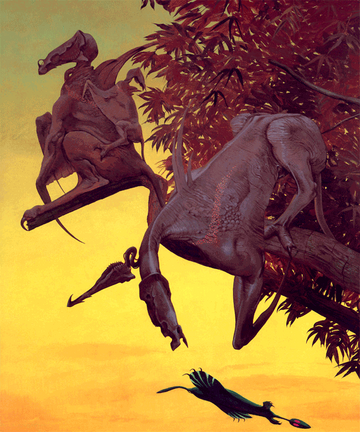
"It was necessary for the hunters to hook them on the wing."
Daggerwrists mostly prefer a diet of trunk-suckers (rarely, though, do they attack prey larger than themselves). Once attached to a trunk, the trunk-suckers are apparently impossible for the daggerwrists to remove. It is necessary for the hunters to hook them on the wing, using their honed wrists or lower jaws, a feat which challenges both species' aerobatic survival skills. At times, though, if a Trunk-sucker is too old or weak, it cannot attach itself to the bark all that well, leaving it vulnerable to a Daggerwrist prying it off, knocking it to the forest floor and parachuting after the dying flier.
Sometimes, Trunk-suckers will feed from gashes on the trees made by climbing Daggerwrists. Often, Daggerwrists will return to many of the same trees they have previously visited before and wait for Trunk-suckers to feed from their climbing gashes.
Daggerwrists always have various attitudes of repose and conflict. They are an energetic species with interesting habits.
Troupes will often follow their intended prey as far as on the outskirts of the forest. They have supreme confidence in the forest as they swing from bough to bough, then glide through the air between trees. Nothing impedes their progress and they can cover a kilometer to their goal in five minutes, which is quite remarkable considering the density of the foliage. At least one member of the troupe will indicate that the prey will be near. The small bands communicate with bursts of sonar pings and follow the movements of their prey. The troupe will gather silently in a circle around such intended victims, like trunk-suckers at roost-trees, in preparation for their ambush. It will be each individual daggerwrist for itself, with little or no team effort beyond the first surprise assault.
At certain times, a daggerwrist may act unpredictably violent towards others of its kind and proceed to kill and then cannibalize a few other individuals. Other daggerwrists in the cannibal's troupe seem disturbed by this cannibalistic display, making tentative mock attacks on the feeding cannibal. Each attack, however, can be rebuffed by the cannibal who emits a string of ominous, low frequency pings. The only clue that this might be aberrant behavior is the hostile manner in which a troupe deals with the maddened individual. There have been a few possible explanations, among them that the individual is deranged, that there might be some environmental reason for its needs, or that it is the result of its supposed elevated status among its fellows. Whatever the cause, troupes seem uncomfortable with the gruesome result, normally not eating their own kind. Sometimes, though, the troupe can revolt against a cannibalistic individual if it goes too far in its behavior, for multiple reasons. They band together and will proceed to mercilessly slaughter the cannibal to death with their daggers. A certain justice will be dealt.
Oddly enough, though, - according to one eyewitness account - an individual that has previously mated with the cannibal will go the slaughtered body. With almost surgical precision, it slits the dying or dead cannibal's distended belly from crotch to breastbone. Then, sometimes, astonishingly, out pops a blood-soaked infant daggerwrist, shaky and uncertain, but clearly alive and well (though sometimes they end up not being alive). It leaves its dead dam, hops upon the waiting back of its sire, digs its soft unformed daggers into the rugose skin, and clings with all its might as its troupe turns and disappears into the forests. This leads to the assumption that these cannibalistic individuals' strange behavior is the result of pregnancy.
